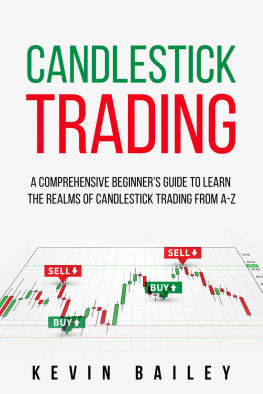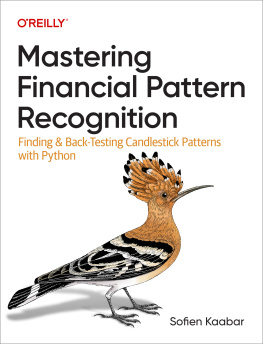CANDLESTICK CHARTING EXPLAINED
CANDLESTICK CHARTING EXPLAINED
Timeless Techniques for Trading Stocks and Futures
Third Edition
Gregory L. Morris
with Ryan Litchfield


Copyright 1992, 1995, 2006 by Gregory L. Morris. All rights reserved. Except as permitted under the United States Copyright Act of 1976, no part of this publication may be reproduced or distributed in any form or by any means, or stored in a database or retrieval system, without the prior written permission of the publisher.
ISBN: 978-0-07-163217-1
MHID: 0-07-163217-4
The material in this eBook also appears in the print version of this title: ISBN: 978-0-07-146154-2, MHID: 0-07-146154-X.
All trademarks are trademarks of their respective owners. Rather than put a trademark symbol after every occurrence of a trademarked name, we use names in an editorial fashion only, and to the benefit of the trademark owner, with no intention of infringement of the trademark. Where such designations appear in this book, they have been printed with initial caps.
McGraw-Hill eBooks are available at special quantity discounts to use as premiums and sales promotions, or for use in corporate training programs. To contact a representative please e-mail us at bulksales@mcgraw-hill.com.
This publication is designed to provide accurate and authoritative information in regard to the subject matter covered. It is sold with the understanding that neither the author nor the publisher is engaged in rendering legal, accounting, futures/securities trading, or other professional service. If legal advice or other expert assistance is required, the services of a competent professional person should be sought.
From a Declaration of Principles jointly adopted by a Committee of
the American Bar Association and a Committee of Publishers
TERMS OF USE
This is a copyrighted work and The McGraw-Hill Companies, Inc. (McGraw-Hill) and its licensors reserve all rights in and to the work. Use of this work is subject to these terms. Except as permitted under the Copyright Act of 1976 and the right to store and retrieve one copy of the work, you may not decompile, disassemble, reverse engineer, reproduce, modify, create derivative works based upon, transmit, distribute, disseminate, sell, publish or sublicense the work or any part of it without McGraw-Hills prior consent. You may use the work for your own noncommercial and personal use; any other use of the work is strictly prohibited. Your right to use the work may be terminated if you fail to comply with these terms.
THE WORK IS PROVIDED AS IS. McGRAW-HILL AND ITS LICENSORS MAKE NO GUARANTEES OR WARRANTIES AS TO THE ACCURACY, ADEQUACY OR COMPLETENESS OF OR RESULTS TO BE OBTAINED FROM USING THE WORK, INCLUDING ANY INFORMATION THAT CAN BE ACCESSED THROUGH THE WORK VIA HYPERLINK OR OTHERWISE, AND EXPRESSLY DISCLAIM ANY WARRANTY, EXPRESS OR IMPLIED, INCLUDING BUT NOT LIMITED TO IMPLIED WARRANTIES OF MERCHANTABILITY OR FITNESS FOR A PARTICULAR PURPOSE. McGraw-Hill and its licensors do not warrant or guarantee that the functions contained in the work will meet your requirements or that its operation will be uninterrupted or error free. Neither McGraw-Hill nor its licensors shall be liable to you or anyone else for any inaccuracy, error or omission, regardless of cause, in the work or for any damages resulting therefrom. McGraw-Hill has no responsibility for the content of any information accessed through the work. Under no circumstances shall McGraw-Hill and/or its licensors be liable for any indirect, incidental, special, punitive, consequential or similar damages that result from the use of or inability to use the work, even if any of them has been advised of the possibility of such damages. This limitation of liability shall apply to any claim or cause whatsoever whether such claim or cause arises in contract, tort or otherwise.
To Dusti, Grant, Derek, and Kane
Contents
Foreword from the Second Edition
I am a collector of first editions of books. My specialties include astronomy texts written before 1900, such as Percival Lowells classic Mars, the first published speculations about the possibility of life on the red planet (which inspired Jules Verne to write The War of the Worlds), and a strange little tome from 1852 that claims astronomer William Hershel spotted sheep on the Moon with his telescope.
My collection also includes about 200 business books written by authors I have interviewed through the years. My inscribed copy of Ivan Boeskys Merger Mania, for example was appraised a few years ago at $200.
But my sentimental favorite is a beat-up old chart book of the Dow Jones Industrials and Transportation Averages going back to December 18, 1896, the day the modern Dow Jones averages were born. (Trivia question: Where did the Dow Industrials close after its very first day of trading? Answer: 38.59). Back then, the Industrials only had 12 components, and the Transports, with 20 issues, were known as the Rails.
A 90-year-old FNN viewer from Virginia offered it to me in the fall of 1985.
I have been interested in, but not too active in, the market since the early 20s he wrote, and lived through the 29 break and the great depression which was a tempering influence against excessive enthusiasm.
At age 90 my activities are confined to growth stocks and safe investments. I am no longer interested in speculation. So he wondered if I would be interested in his chart book.
Indeed, I was. I gladly accepted in exchange for a signed copy of one of Joe Granvilles books.
The book was published in 1931 by Robert Rhea, the famed disciple of Charles Dow and of the oldest form of technical analysis, the Dow Theory. It covers the years 18961948, with each page devoted to one years trading of both averages.
It is one big, faded green rectangle, measuring 11 inches high and 18 inches across. Its heavy cardboard covers are held together by a couple of rusty screws.
I browse through it once in awhile, marveling at its simplicity. Each days closing value is designated by a single horizontal hash mark meticulously notched on the graph paper.
Nothing fancy. No intraday highs and lows, no trendlines, no points or figures, just a simple daily record of the debits and credits of civilization.
There is the market panic in December of 1899, when the Industrials plunged from 76 to 58 in just 13 trading days.
There is the period from July to December of 1914, when, incredibly, the market was closed on account of World War I. Eerily, half the page devoted to that year is blank.
And, of course, there is 1929, when the Industrial peaked on September 3 at 381.17 and hit a bottom, three pages later, in July of 1932 at 41.22.
The book means a lot to me. Between its covers there is a bit of history, some mathematics, a dose of economics, and a dash of psychology. It has taught me much about a discipline that I once considered voodoo.
Good journalists are supposed to maintain an open mind about the stories they cover. Political reporters, for example, should be neither Republican nor Democrat. And successful financial reporters should avoid being either bullish or bearish. And they should also be familiar with both fundamental and technical analysis.
I remember the first time I interviewed a technical market analyst in the fall of 1981, when I was still cutting my teeth on business news. This analyst spoke of 34-day and 54-week market cycles and head-and-shoulder bottoms and wedge formations. I thought it was so much mumbo-jumbo until the summer of 1982 when the bull market was launched, and the fundamental analysts were still bemoaning the depths of the recession that gripped the economy at the time. That was when I realized the technicians may have something there.
Next page








